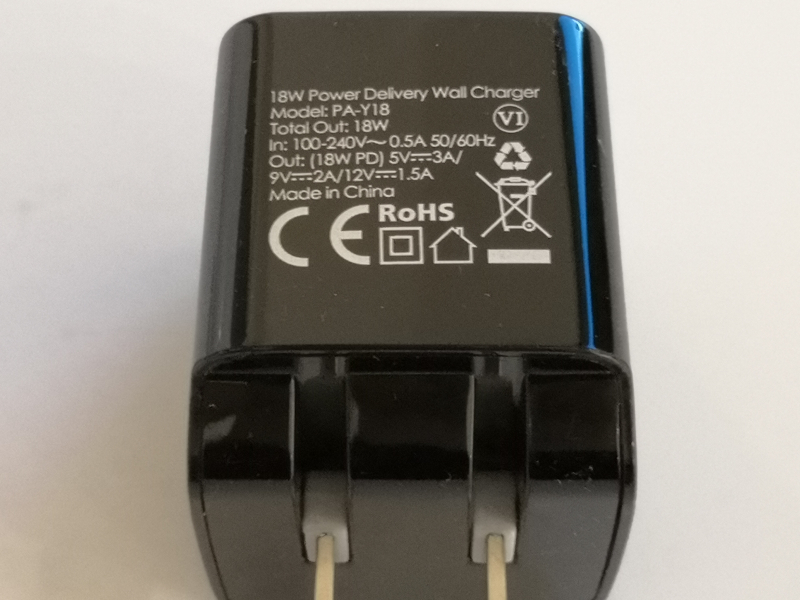Charging Technology Speed Performance Benchmarking
Chargers and Power Banks
Headphone & Speakers
Cases & Covers
Virtual Reality
Cables & Adapters
Media Player
Laptop
Tablet
Desktop
Cell Phone
Printers & Copiers
Memory Cards
TV
Computer Display
Game Console
Smart Home
Wearable Technology
Photo & Video Camera
Car Electronics
Car
Networking Equipment
Smart Toys
Home Audio & Video
Professional & Industrial
Storage Drive
Docking Station
Game Console Controllers
Set-top box
Keyboard, Mice, & Stylus
Portable Music Player
Computer Parts & Components
Cordless & Speakerphones
Projector
Software
Reporting
PA-Y18 18W PD 3.0 USB-C Wall Charger
by AUKEY





Interested in this product?
The Aukey PA-Y18 18W PD 3.0 USB-C Wall Charger Can Use USB Power Delivery 3.0 to Quickly Charge Your Phone While Fits Easily In Your Bag

The Aukey PA-Y18 18W PD 3.0 USB-C Wall Charger can be used to rapidly charge your latest iPhone XS, iPhone XS Max, iPhone XR, Google Pixel 2 XL or tablets such as the Huawei MateBook or other USB Power Delivery enabled mobiles using USB Power Delivery 3.0 technology over its USB Type-C connector. Note if you need to charge your iPhone you need to use the Apple USB-C to Lightning Cable. The newer PD 3.0 version should also enable the Aukey PA-Y18 18W PD 3.0 USB-C Wall Charger to provide more efficient charging at lower temperatures when supplying power to USB Type-C devices.
The charger is similar to the other 18W based AUKEY PA-Y15 Amp 18W PD 3.0 USB-C Wall Charger model but appears much smaller. Other than the 15 watts (5 volts @ 3 amps) and 18 watts (9 volts @ 2 amps) power profiles which the Aukey PA-Y18 18W PD 3.0 USB-C Wall Charger also supports, it also uses an additional 18 watts (12 volts @ 1.5 amps) over Power Data Objects (PDO) protocol communication through PD 3.0. Unlike the PA-Y15 model, the PA-Y18 only supports fixed PDO's and doesn't use Programmable Power Supply (PPS) for PD 3.0 charging.
The Aukey PA-Y18 18W PD 3.0 USB-C Wall Charger comes with foldable AC power prongs without any USB Type-C cable accessory so make sure to carry along your own cable.





The Aukey PA-Y18 18W PD 3.0 USB-C Wall Charger is a very compact option if you need USB Power Delivery 3.0 through USB Type-C although it only comes with a single USB Type-C port. While you will not be able to charge two devices at the same time, the charger has enough power to provide decently fast charging to a lot of phones. But if you want more PD 3.0 options with higher output, you may consider the 27W based AUKEY PA-Y8 PD 3.0 USB-C Wall Charger or a dual port wall charger like the AUKEY PA-Y10Amp PD 3.0 USB-C Wall Charger with an additional USB Type-A port for legacy charging.
To have a quick look at the Aukey PA-Y18 18W PD 3.0 USB-C Wall Charger's support of power, we used the USB Power Test App from Granite River Labs with the Granite River Labs USB Power Delivery Compliance C2 Tester to produce the following test results.
The USB Power Test App first negotiates a power contract for every PDO supported by the Aukey charger, and increases the load gradually to find the threshold where over current protection (OCP) kicks in and voltage and current start to drop for safety reasons.
The USB Power Test App reports out all the PDO's supported by the Aukey charger and their OCP thresholds. OCP thresholds for the charger are set at about 17-25% above the maximum current levels for the fixed PDO's.
| PDO | OCP (A) |
|---|---|
| PDO#1 Fixed: 5V 3A | 3.52 |
| PDO#2 Fixed: 9V 2A | 2.41 |
| PDO#3 Fixed: 12V 1.5A | 1.88 |
The USB Power Test App from Granite River Labs also produces an I-V curve which graphically shows the relationship between voltage and current for each PDO. We can observe just a slight current fold-back behavior for the 1st PDO where as the current increases beyond the OCP threshold, the voltage starts to bend down rather than immediately shutting off. The other PDO's show the voltage immediately shuts off when crossing the OCP threshold.
The USB Power Test App can also use the Granite River Labs USB Power Delivery Compliance C2 Tester integrated with the GW Instek APS-7100 programmable AC power supply to compare the charger's power output vs power input so that power efficiency can be measured and compared to regulatory limits from United States of Energy (DOE) Level VI or European Union's CoC Tier 2 requirements. We can repeat the power efficiency tests for different PDO's, current load conditions, and different AC input ranges, allowing us to get a complete picture of power efficiency ranges across all different usage scenarios.
View Full Article
USB PD Charging Technologies & Battery Life Benchmarking
Featured Products
 GTrusted
GTrusted


































